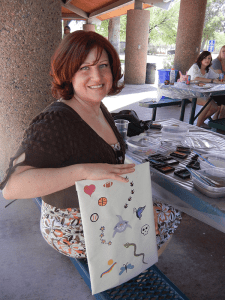First, I’d like to start by saying that no chickens were harmed in the making of this article.
Second, I’d like to announce to the world that I have a diagnosis – and it makes sense.
In May of 2009 I was living in the Phoenix area. A friend flew down from Cincinnati and I took him to all of the spots I felt he should see, including the Grand Canyon. Even with my fibromyalgia going nuts, I still made it a decent distance down a path into the canyon. The weather was perfect. We passed a bunch of burros hauling people out of the canyon. Everyone seemed a bit cheery because it was a great day all around.
That was my only foray for the year into an area where ticks feasted on hosts, since all of my time was consumed by full time work and full time school, so it was a treat for me to get away from everything with my friend.
Going back and reviewing my records, I actually developed symptoms a few months after that, but I didn’t know everything was related from 2009 to present. For instance, I had an ER visit for a painfully stiff neck; it was terrible and I was unable to sleep for four days, which prompted me to develop hallucinations. The constant rocking sensation started around the same time.
I took a turn for the much worse in July of 2010. That’s when I developed severe vertigo, fatigue, blurred vision, head nodding, and partial facial paralysis. In July of 2011, I finally got my first shunt; it seemed to work properly, so I didn’t keep looking for the etiology to explain why I had trouble with the CSF pressure.
Fast forward to May of 2015, seventeen days after my tenth surgery, when it appeared that the shunt failed again; the neurosurgeon who operated on me threw up his hands and said,
“Chels, I don’t know what this is, but I don’t want to operate again.”
I was devastated. I begged him to order a shunt study because I knew it was clogged again. Instead of having me stand upright, which is when the shunt doesn’t drain, they had me lay flat for the test – and then gleefully proclaimed my shunt to be “just fine.” I told them the problem isn’t when I’m laying down, it’s when I’m upright, but the neurosurgeon refused to order another test.
Without a working shunt, I was not able to go back into the work force, and therefore couldn’t maintain a house (and the payment!). I relocated to the Minneapolis/Saint Paul area. I hoped to get into the Mayo Clinic because they are supposedly the number one place in the U.S. for neurological issues, and I certainly had those. When they rejected my case for the fifth time, they said “The patient is too rare to diagnose, and too rare to treat.” It seemed in line with the 42 doctors I had seen up to that point.
With every step I took, in my head I thought the words, “I’m rare. I’m rare. I’m rare.” I told everyone who asked that there was no diagnosis for me. I begged local doctors to keep seeing me, or send me to the big hospitals like Johns Hopkins or the Cleveland Clinic to try to figure out something, anything. I had no idea what to tell people when they asked my prognosis or what would be used to treat me.
I was ready to sacrifice a chicken or do a dance around a fire or read runes. Science had failed me; what about superstition?
I had some pain that I wanted to try to get assistance with from a naturopath instead of a traditional doctor so I could avoid the opioid mess if at all possible. I thought my fibromyalgia was flaring, especially acute burning in my right hip, which would my sleep down to 2-3 hours a night because the pain would awaken me.
I traveled with my usual 250+ pages of medical records, all sorted by year and specialty. After our initial meeting, she said,
“Chels, I really think you should get tested for Lyme.”
About the Author: Patient Worthy Contributor, Chelsea. Keep an eye out for posts from her as she navigates the gnarly dating world and chronic illness with a sense of humor. Check out her blog, The Sick and The Dating.
Will Chelsea find out she has LYME disease? It is often referred to as the great imitator. Stay tuned, same time tomorrow to find out.







